This column's recent exposé on the pyramid-shaped structures strewn across a paddock in the Lanyon Valley (Why these metal pyramids are in a Tuggeranong paddock, August 27) resulted in a bulging mailbag.
Despite clearly dismissing suggestions by some that they were out of place tank traps, or even aircraft beacons, several readers "found it hard to believe" that the tetrahedrons (the ones with four sides, and sometimes called a triangular pyramid) and octahedrons (yes, eight sides) were part of the formwork from the construction of the triagrid ceilings at the National Gallery of Australia in the late 1970s early 1980s.
"Really, why would they still be around, why would someone keep them?" questioned Chris Jones, of Hackett.
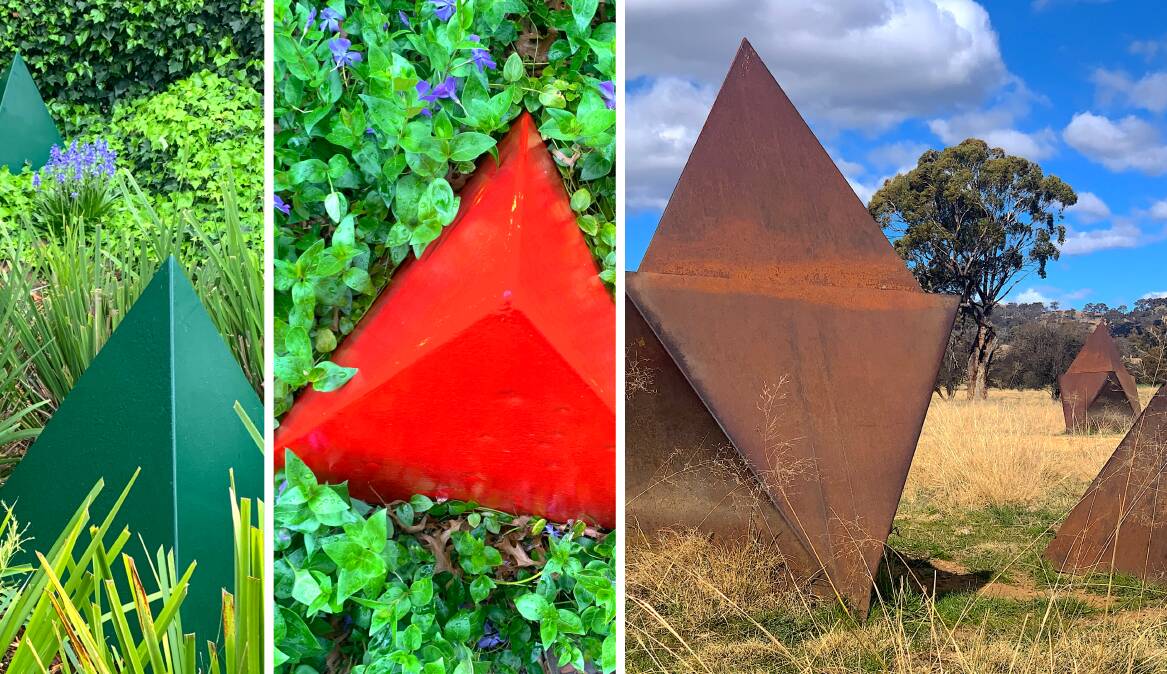
Meanwhile, other readers were buoyed by the fact that someone had gone to the effort to stash them away for four decades.
"They are national treasures, as much a part of our art history as those on display in gallery," argued Penny Matthews, of Kambah.
Impetus
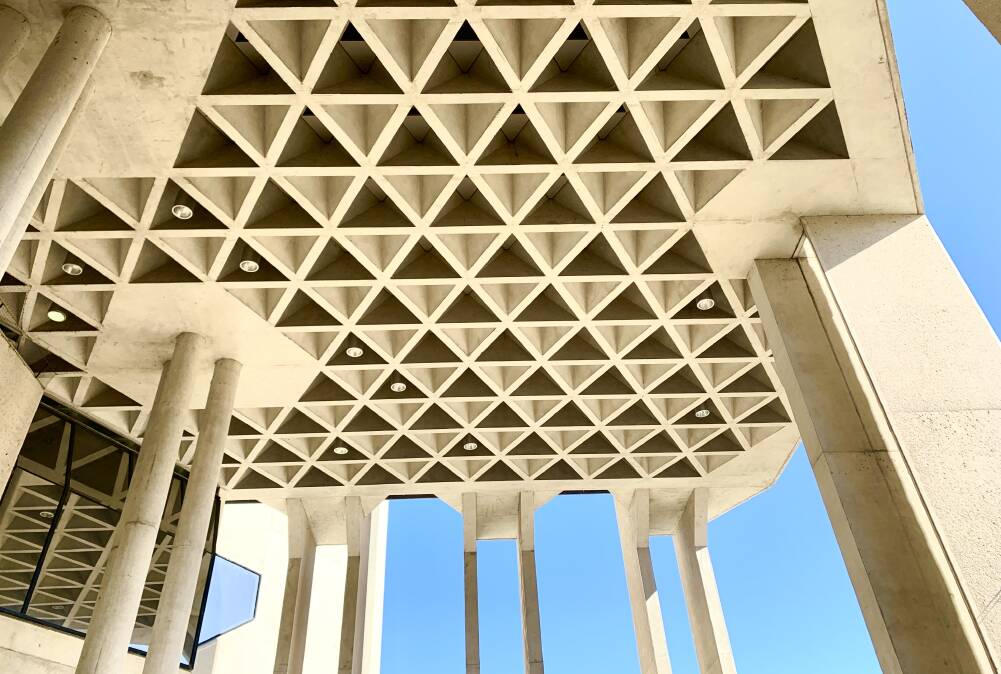
The most compelling correspondence came from Digby Hyles, formerly of Canberra and now of Cootamundra, who confessed that he was in fact the person responsible for rescuing the curious formwork from the gallery back in 1981.
"During the construction phase of the gallery, James Mollison, the then director, was always talking about how someone should use these formworks to make sculptures," Digby recalls.
"So, when no one took up his offer, I wrote a letter requesting 35 of each shape," Digby says, adding, "The numbers were arbitrary, I just plucked them out of the air.
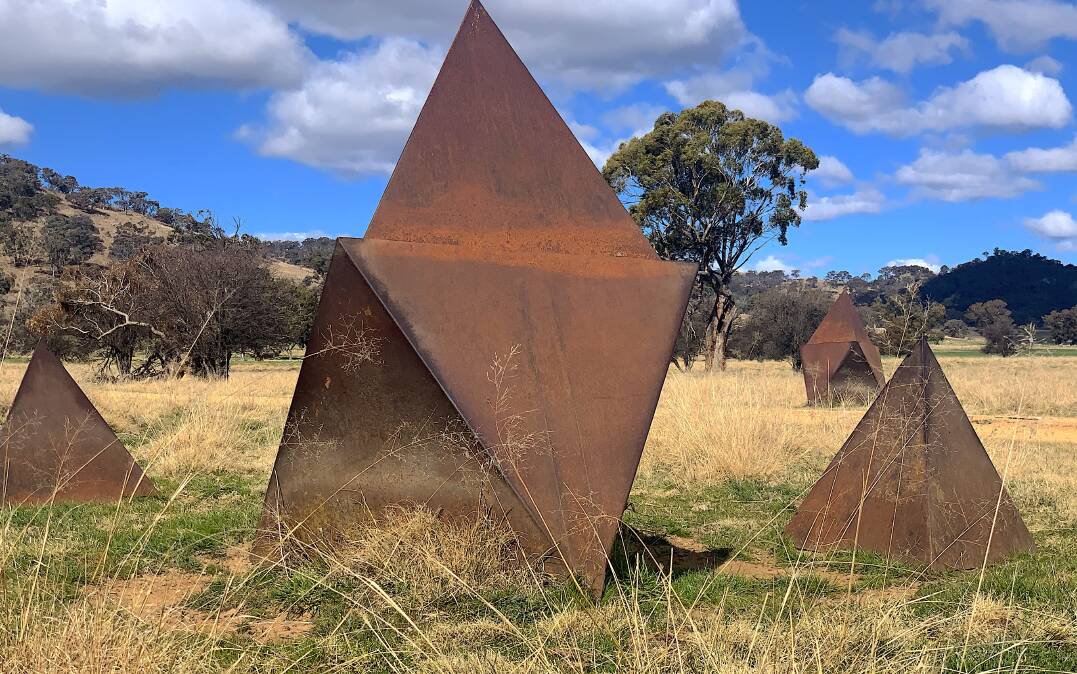
"I didn't hear back for some time until one day I received a typed response from the gallery approving my request," Digby says. "But there was a catch, I had to arrange and pay for their transport.
"I was told that the octos and tetras were going to be removed from the building in a couple of days, and if I really wanted them, I had to act quickly."
Not wanting to miss out on the opportunity to officially souvenir the eye-catching formwork, Digby promptly organised a tip-truck to transport the tetrahedrons from the gallery to Castle Hill, his family's property, near Tharwa. "The 35 only just fitted in," he laughs.
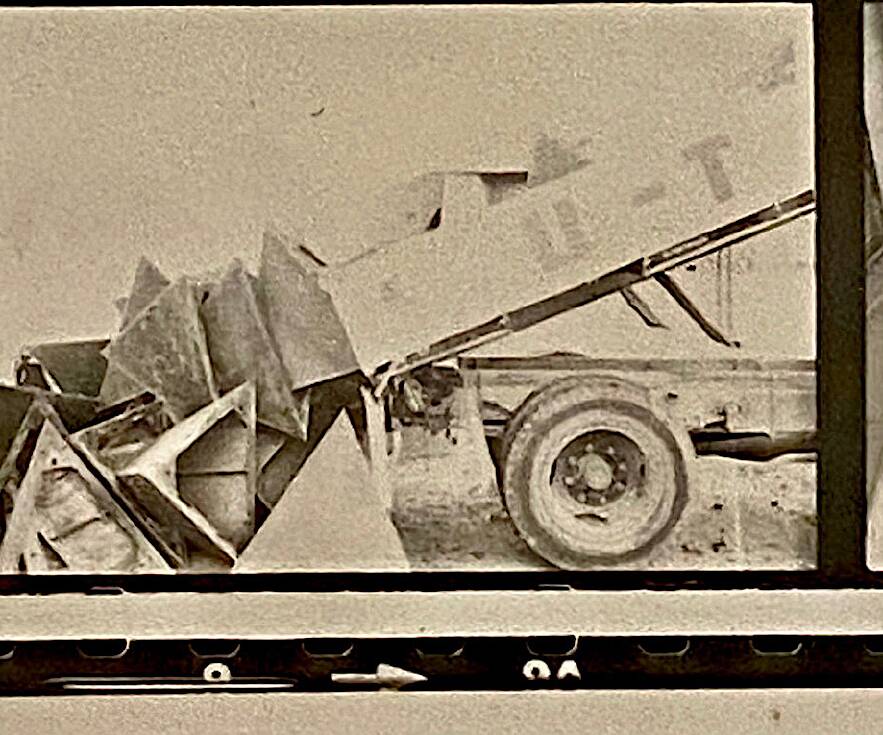
Next came the much larger octahedrons. "They required a different transport solution ... a semi-trailer," Digby exclaims, adding, "We then unloaded them into the hay shed at Castle Hill."
While Digby had hoped to build a sculpture with the metal shapes, even creating a cardboard model of his plans, soon after stacking the stash into the hay shed, he ended up moving into the city, and with that his plans evaporated.
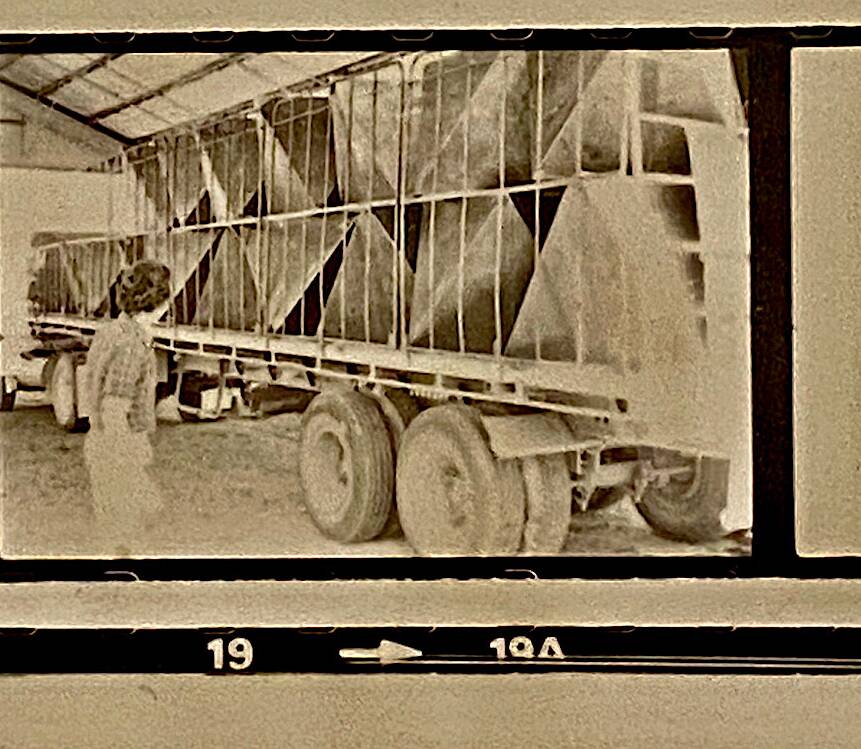
"I had no room for 70 oversized metal shapes in my Lyneham yard," he muses.
Over the years, the metal framework has been given away to visitors to the property, including Digby's sister Wendy Greenhalgh who "loves them" and took seven tetrahedrons with her when she moved to the inner south.
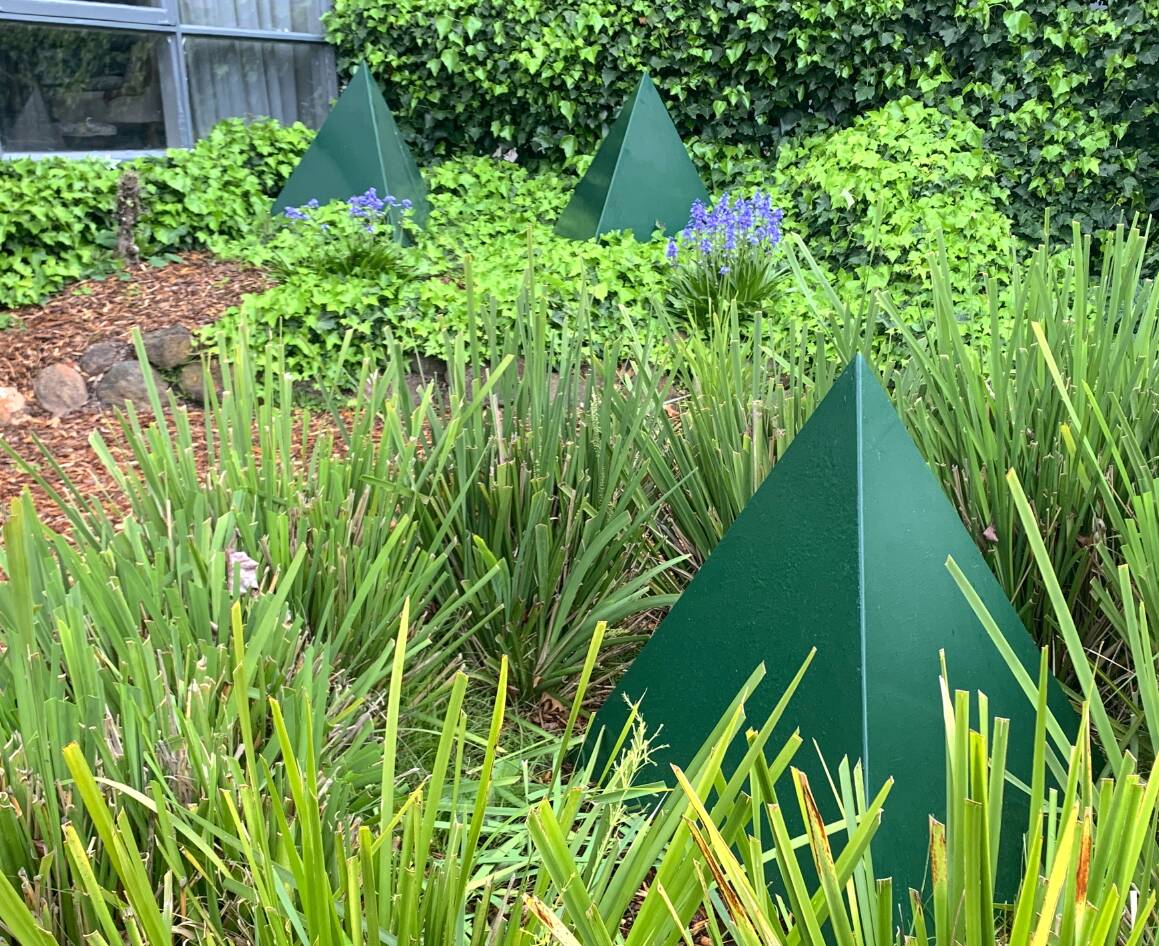
Now, painted dark green, they take pride of place as features in her front and back garden and another painted bright red marks the entrance to her driveway.

On a recent visit to view the gallery artefacts I noticed several of the tetrahedrons had small pockmarks in them and asked if that was damage sustained during transportation. "Oh no, those dents date from when they were out at the farm and used by others for target practise," she laughs.
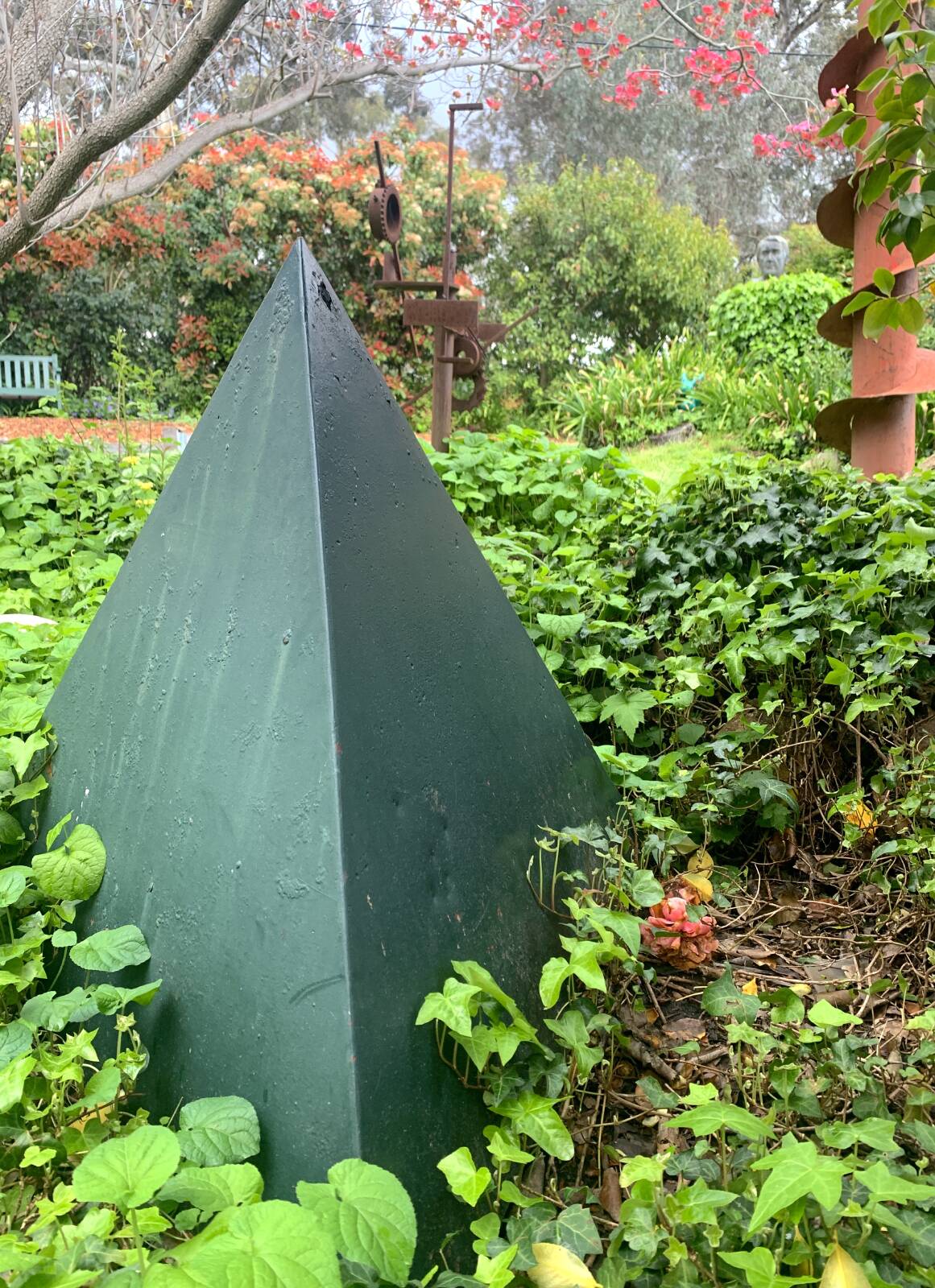
The case of the spiral staircase
Seventy pieces of metal formwork aren't the only relics that Digby Hyles managed to salvage from the construction phase of the gallery.
"The initial spiral staircases they put in the gallery weren't fit for purpose, they weren't practical for conservators to walk up and down while holding boxes, so just before the gallery opened, I put in a request for one."
Digby didn't even have to arrange for transport this time, and soon a complete spiral staircase was plonked in his front yard in Mackennal Street, Lyneham.
Then came the hard work. "It was massive, and it took me months to move it with a crowbar, inch by inch into the backyard, where I used it as an artistic viewing platform," Digby recalls.
However, soon after he wrestled the staircase into position, he received a call from the gallery indicating they'd made a blunder and discarded the wrong staircase.
"They came back and collected it with a crane and replaced it with the correct staircase to be discarded," Digby recalls, adding, "Thankfully this one was cut in two so easier to move."
As to where the discarded stairs are now, Digby has no idea. "I left them behind when we moved, so who knows it might still be there," he laughs.
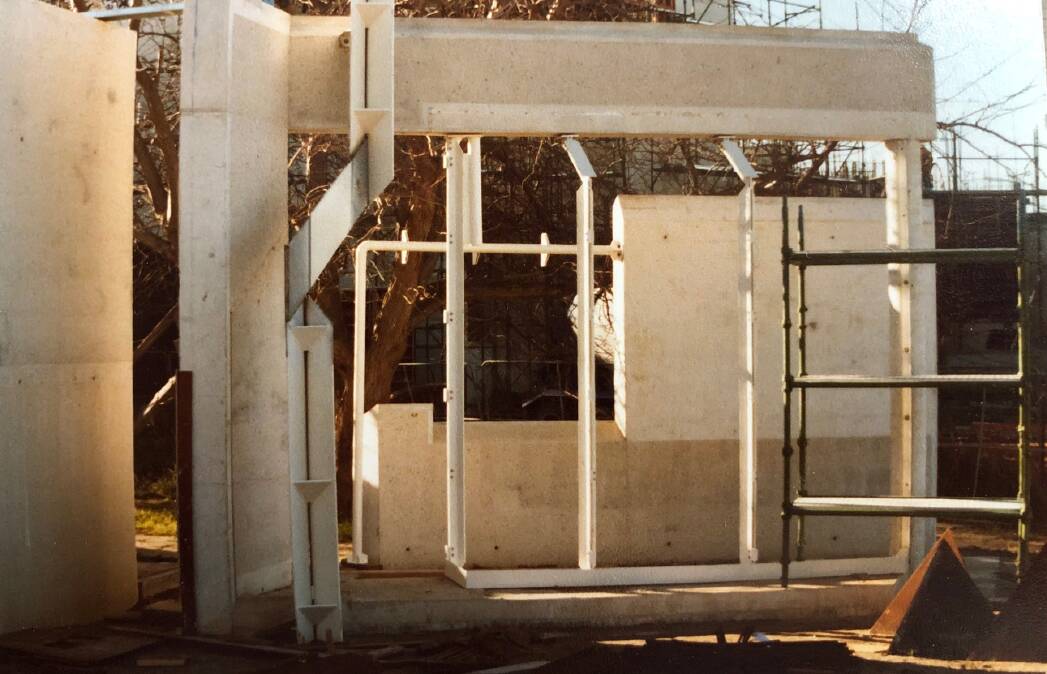
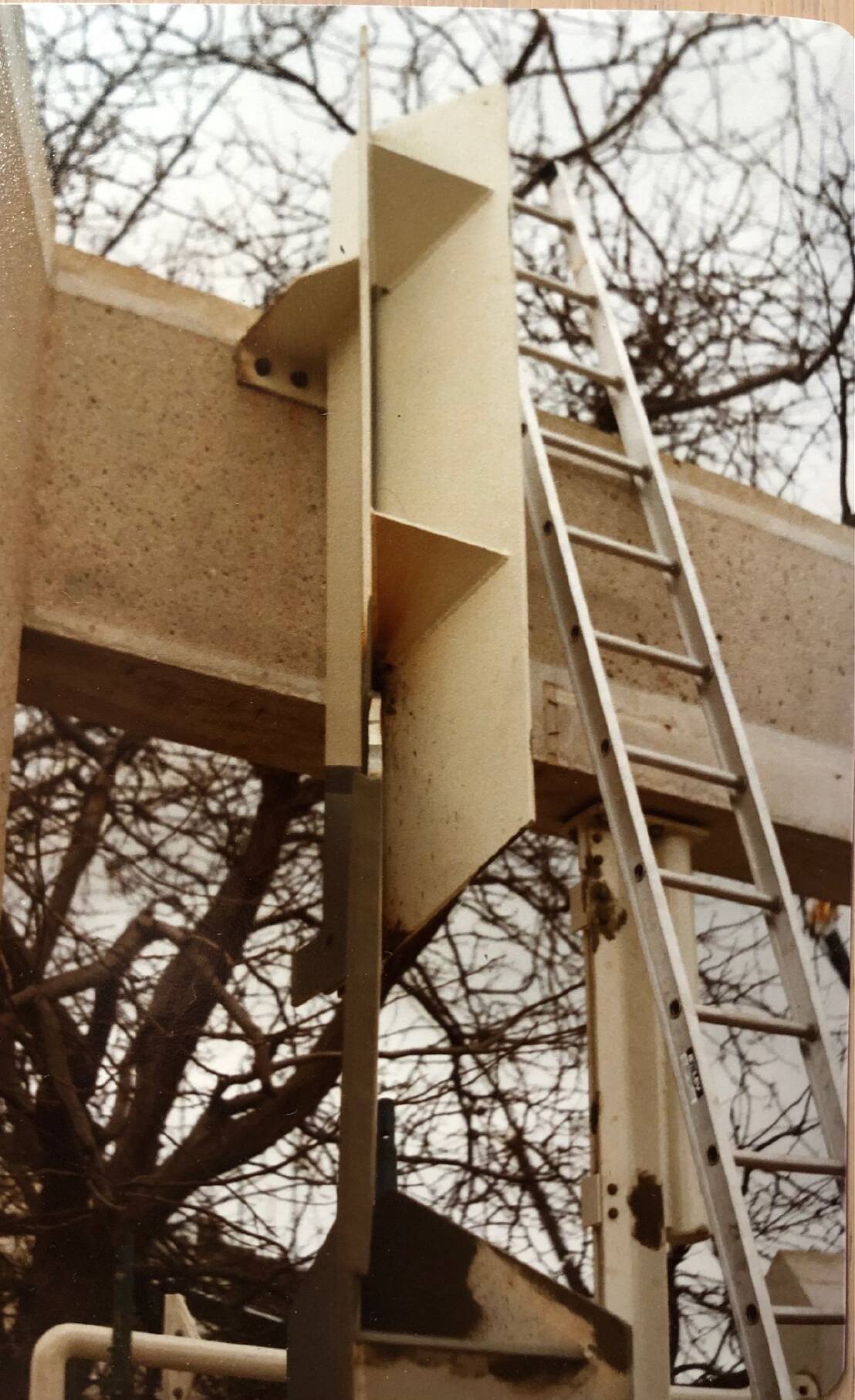
Prototype buildings
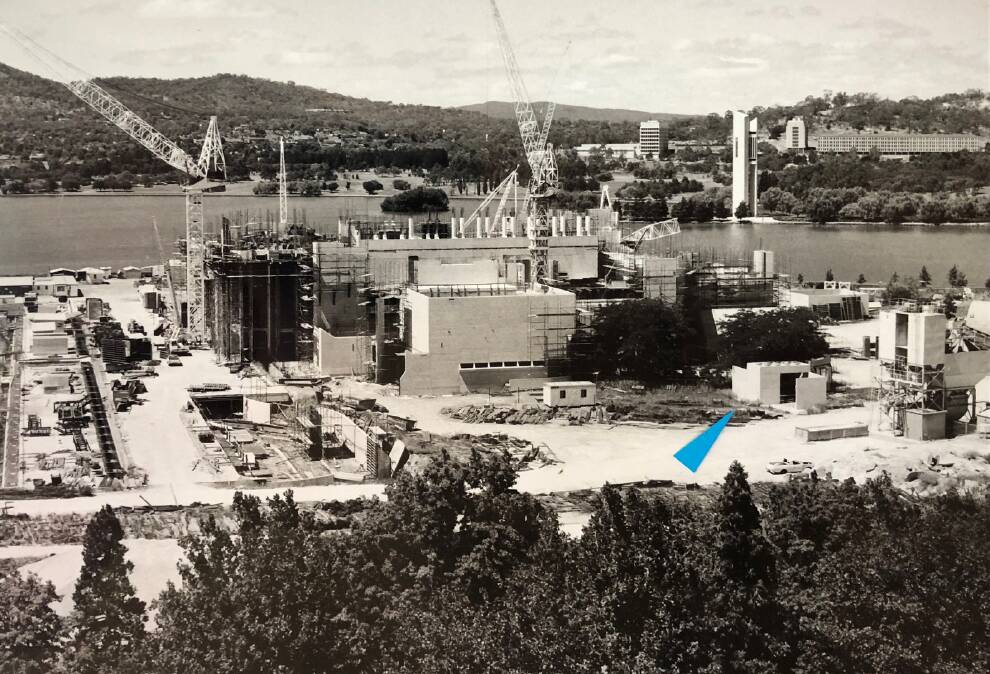
The gallery's construction involved innovative techniques, which were tested on several protype buildings built adjacent to the main building.
One of these prototype buildings survived for many years at the western end of the gallery but was demolished as part of the 2010 extensions.
Thankfully, the prototype building for the High Court of Australia - built around the same time so various building methods, including sandblasting techniques could be finessed - is still standing.

It's located just to the north-west of the High Court of Australia but is not in original condition. Several glass walls were removed due to vandalism and in 1999 the trial cascading waterfall was paved over.
Disappointingly there is no interpretative sign to explain the significance of this prototype building in the construction of the High Court, one of the Parliamentary Triangle's most striking buildings.


Curious calling card confession
Meanwhile, Alan Carey, one of the many tradesmen who worked on the construction of the National Gallery of Australia, has confessed to leaving his personal mark on part of the triagrid formwork.
Alan, who spent three years of his carpentry apprenticeship working with the tetrahedrons and octahedrons, admits he scratched his initials into the formwork so that after the concrete was poured, they became a permanent part of the ceiling.
"I scratched them in the bottom of the formwork facing down in a corner," he recalls, adding, "I only did the one set, for if I'd done it dozens of times it would have been noticed and someone would have quickly worked out who did it."
Alan explains he was part of the team that worked for three years on the building's triagrid ceiling from start to finish.
"We did everything from set-out, positioning the steel forms, installing the concrete reinforcing, pouring the concrete, and stripping and cleaning the forms ready for the next pour," he explains.
Forty years late, and now retired, Alan reveals he still "loves visiting the gallery to look at the art, and of course, the ceiling."
As to the location of Alan's calling card. "It's in a discrete and never to be disclosed position," he reveals.
Alan's unsanctioned "graffiti" reminds me of the thumb prints convicts sometimes left in handmade bricks during Australia's colonial days.
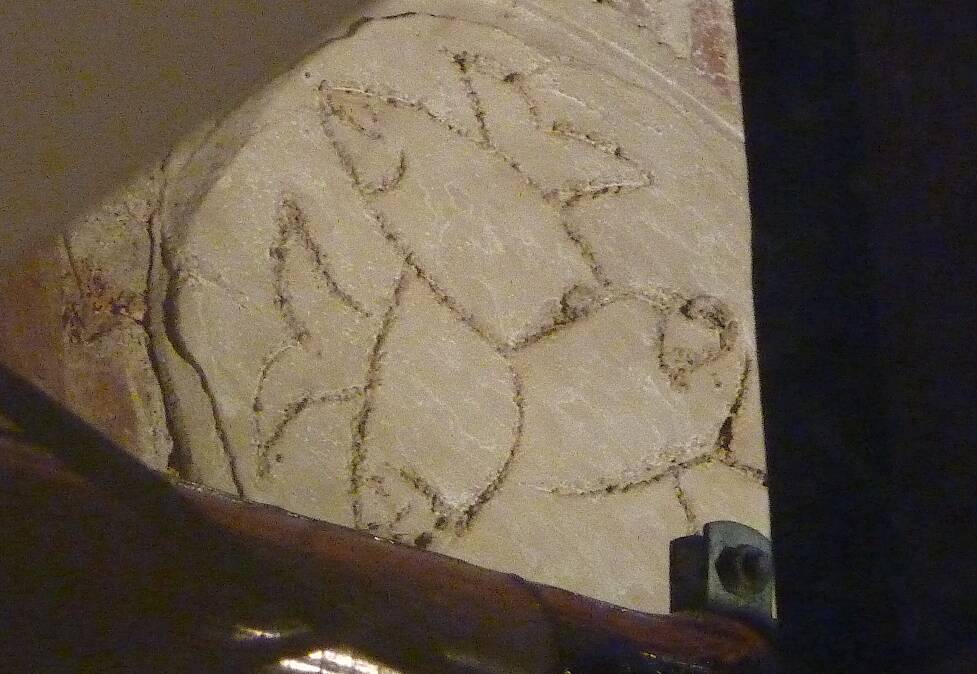
More recently it reminds me of the mysterious fish etched into plaster work of a wall of Old Parliament House. The crude outline of what appears to be three intertwined fish was only rediscovered in 1999 when tradesmen were undertaking restoration work in the ceiling cavity of the basement. Its origins are uncertain, but builders and historians believe it was likely to have been scrawled on the wall by a bored tradesman during the construction of the building in the mid-1920s.
WHERE IN THE REGION
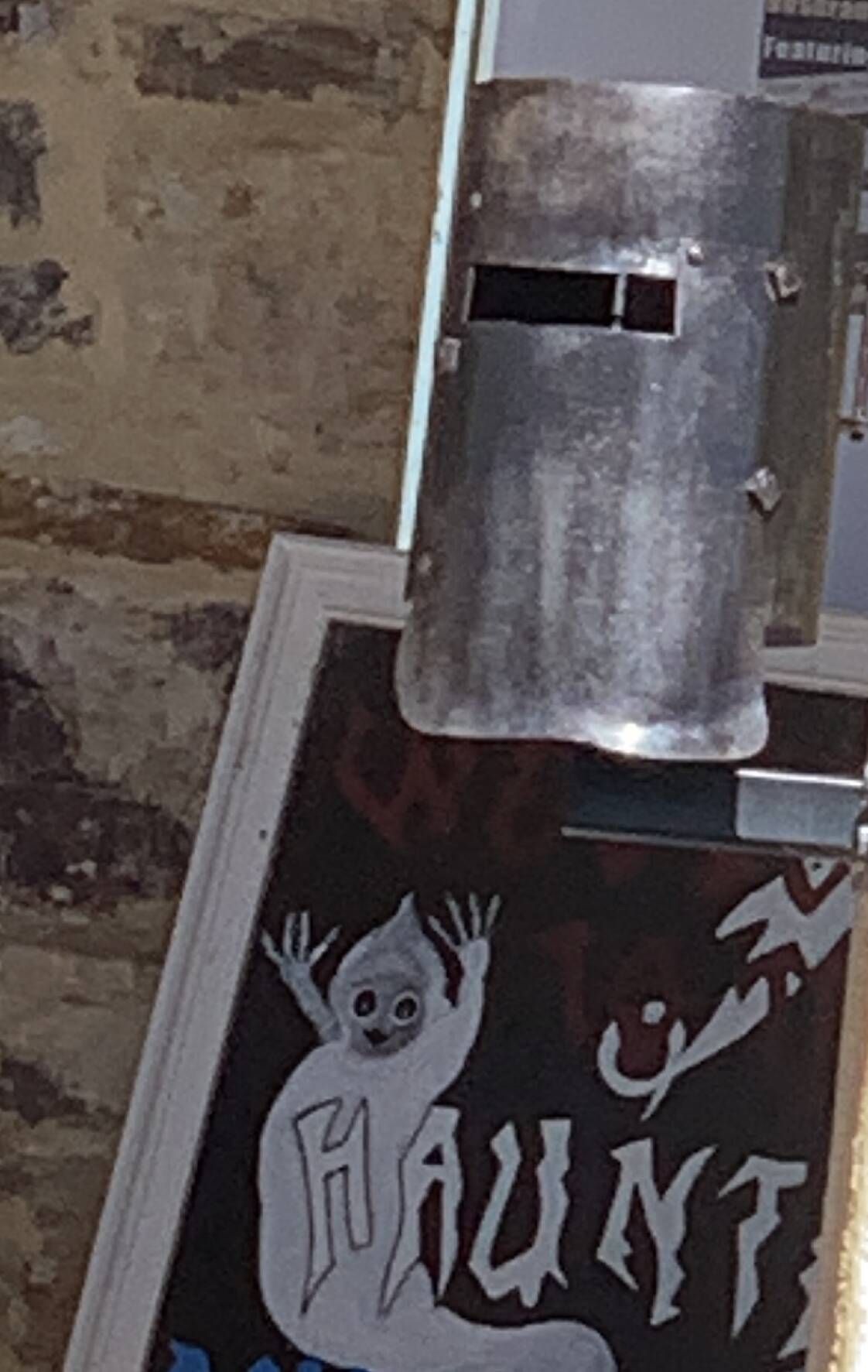
Rating: Medium
Clue: Bushranger by nature, bushranger by name
How to enter: Email your guess along with your name and address to tym@iinet.net.au. The first correct email sent after 10am Saturday, November 12, wins a double pass to Dendy, the Home of Quality Cinema.
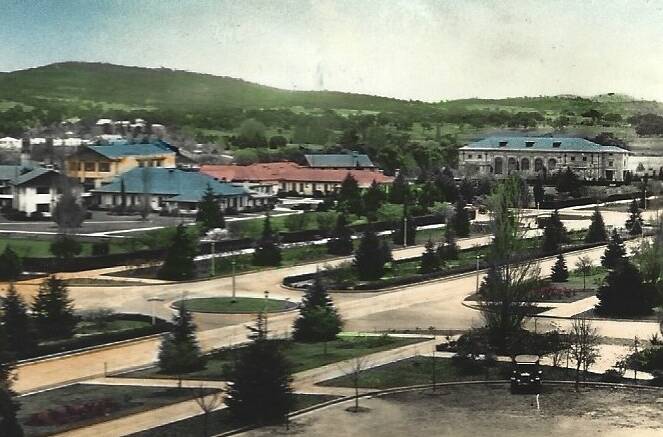
Last week: Congratulations to Bev Kimmorley of Oxley who was first to identify last week's postcard of a circa 1928 view from the top of West Block across to the Hotel Canberra, Albert Hall and beyond. Bev just beat a large number of other readers including Roger Shelton of Spence, Toni Hogan of Bonython, and first-time entrant Liz Dovey of Aranda to the prize. Kevin Mulcahy of Tura Beach reports "it's quite amazing how much of Canberra was built by 1930".
A Grave Tale
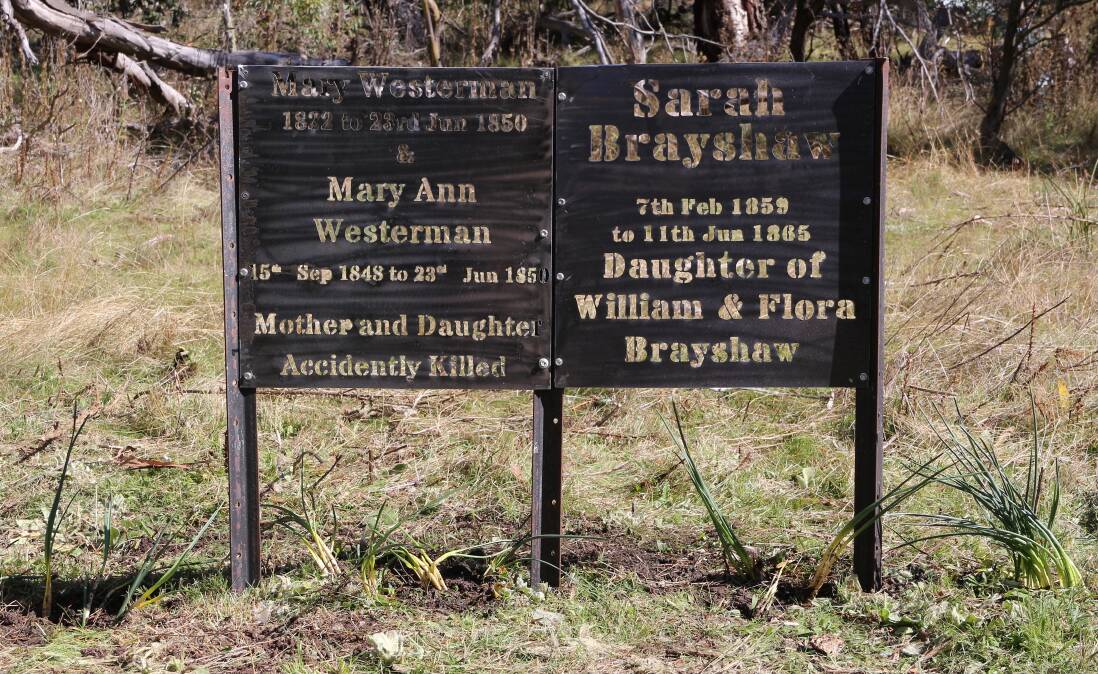
While I'm yet to receive any reports of graves in a similar style to that of Flying Officer Francis Ewen's unusual table-style tombstone in Reid (August 6), the graves of two European pioneers in far-flung Namadgi National Park, which featured in this column earlier this year, have been spruced-up.
Steve Brayshaw, of Adaminaby, reports that the final resting spots of Mary Ann Westerman and Sarah Brayshaw, previously hidden in bush near the ruin of Boboyan Homestead, have been finally marked by two signs.
Regular readers may recall the tragic tale of toddler Mary Ann, who died due to injuries suffered from a dray accident in 1865, was highlighted in a local short film Letter from Bobeyan. The short film directed by Canberra's Stephen Cooke has since screened at many film festivals around the world and received several award nominations.
CONTACT TIM: Email: tym@iinet.net.au or Twitter: @TimYowie or write c/- The Canberra Times, GPO Box 606, Civic, ACT, 2601







